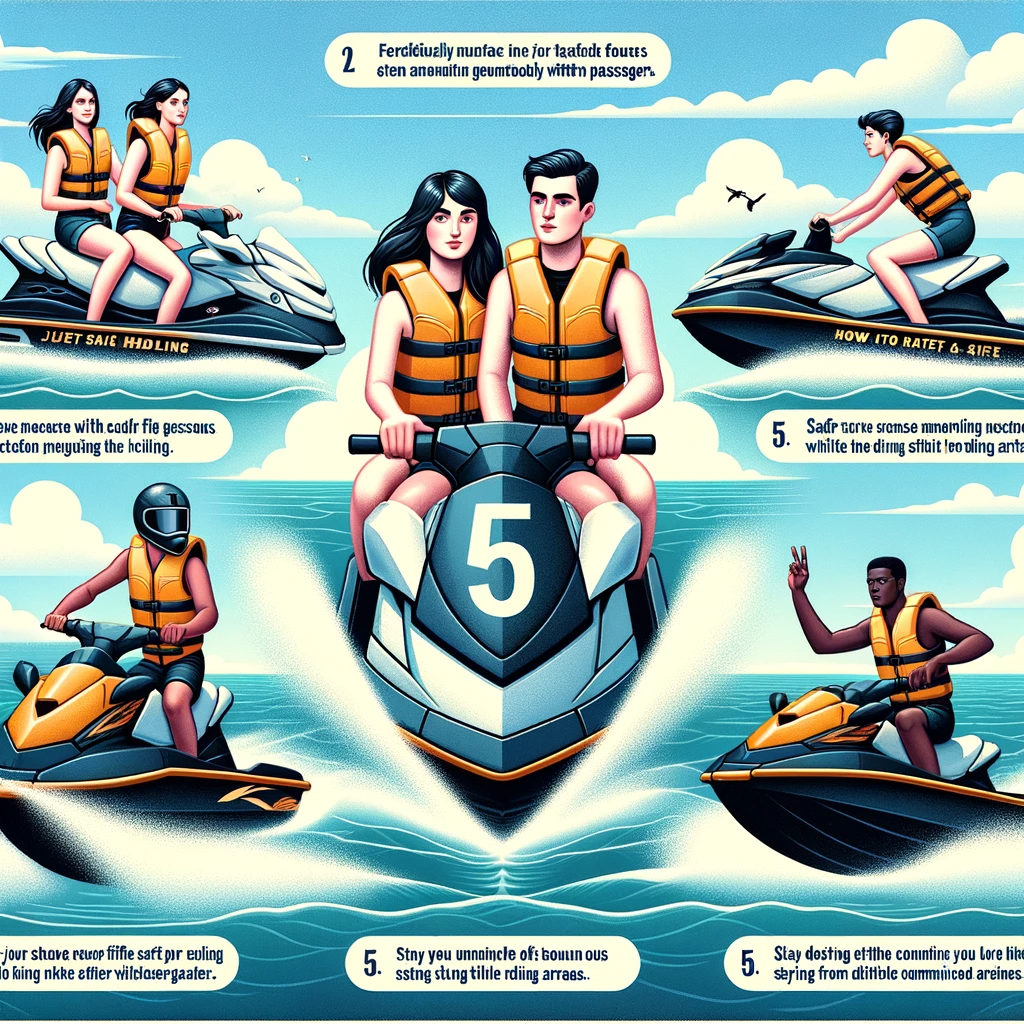5 Essential Tips for Riding Safely with Passengers

Are you ready to hit the waves and experience the thrill of jet skiing? Riding with a passenger can be an exciting and enjoyable experience, but it’s important to prioritize safety. In this article, we will provide you with five essential tips for riding safely with passengers on your jet ski. Whether you’re a seasoned rider or a beginner, these tips will help ensure a smooth and secure ride for both you and your passenger. So grab your life jackets, hold on tight, and get ready for an unforgettable adventure on the water. And for the best jet skiing experience, don’t forget to rent your jet skis from the watersport experts at A2Z Powersport, located in Orange Beach AL.
Proper Safety Gear
Wearing Life Jackets
When riding a jet ski, it is crucial to prioritize safety by wearing a life jacket. A life jacket is designed to keep you afloat in the water and can greatly reduce the risk of drowning in case of an accident or unexpected fall. Make sure that the life jacket fits you properly and is Coast Guard-approved. It is also important to ensure that your passengers are wearing life jackets as well, regardless of their swimming abilities. By wearing life jackets, you can enjoy your jet skiing adventure with peace of mind.
Choosing the Right Helmet
Another essential safety gear for jet skiing is a helmet. A helmet will protect your head from potential injuries in case of a collision or fall. When choosing a helmet, ensure that it meets safety standards and provides a snug fit. The helmet should cover your forehead and the sides of your head, providing adequate protection without obstructing your vision. Wearing a helmet is important not only for your own safety but also to set a good example for your passengers, encouraging them to prioritize their safety as well.
Protective Clothing
In addition to life jackets and helmets, it is recommended to wear protective clothing while jet skiing. This includes a wetsuit or swimwear, which provides insulation and freedom of movement, and water shoes or non-slip sandals to ensure a firm grip on the jet ski. Wearing sunglasses, preferably with polarized lenses, can protect your eyes from the sun’s glare and any debris that may be stirred up while riding. Sunscreen is also vital to protect your skin from harmful UV rays. By wearing the appropriate protective clothing, you can enjoy your jet ski ride comfortably and minimize the risk of injuries.
Educating Your Passengers
Informing Passengers about Safety Rules
When jet skiing with passengers, it is crucial to educate them about the safety rules and guidelines. Make sure your passengers are aware of the importance of wearing life jackets, helmets, and protective clothing. Instruct them to hold on tightly and not to extend their arms or legs outside the jet ski to prevent accidents or injuries. Emphasize the need to follow your instructions and be attentive throughout the ride. By informing your passengers about safety rules, you are ensuring a safe and enjoyable experience for everyone involved.
Explaining Riding Positions
To ensure the safety and stability of the jet ski, it is important to explain the proper riding positions to your passengers. Instruct them to sit or stand behind you, with their hands firmly on your waist or the designated handrails. This will help distribute their weight evenly and reduce the risk of imbalance. Remind your passengers to maintain a stable posture and not to make sudden movements that could affect the jet ski’s stability. By explaining and enforcing the correct riding positions, you can enhance the overall safety and control of the jet ski.
Communicating Hand Signals
Clear communication is essential When riding a jet ski with passengers. Teach your passengers the basic hand signals that you will use to direct them during the ride. For example, a thumbs-up signal can indicate that everything is okay, while a thumbs-down signal can mean that you need to stop or slow down. Demonstrate these hand signals and ensure that your passengers understand their meanings. This will help you convey important instructions or warnings, especially in noisy or crowded environments. By communicating effectively through hand signals, you can maintain a safe and coordinated ride.
Familiarize with the Jet Ski Controls
Understanding Throttle and Brakes
Before embarking on a jet ski ride, it is essential to familiarize yourself with the controls of the watercraft. The throttle controls the speed of the jet ski, and the brakes are used to slow down or bring the jet ski to a complete stop. Understanding how to operate these controls smoothly and effectively is crucial for maintaining control and ensuring a safe ride. Practice accelerating and decelerating gradually to get a feel for the jet ski’s speed and responsiveness. Remember to avoid sudden or jerky movements that could startle your passengers or affect the stability of the jet ski.
Practicing Steering and Turning
Proper steering and turning techniques are vital for maneuvering the jet ski safely. To turn the jet ski, lean slightly in the direction you want to go while simultaneously turning the handlebars. Get accustomed to the responsiveness of the jet ski and practice making gradual turns. Avoid making sharp turns or abrupt movements, as this can cause instability and potentially throw off your passengers. By practicing steering and turning techniques, you can ensure smoother rides and better control over your jet ski.
Handling Emergency Shut-Off
In case of an emergency or if you lose control of the jet ski, it is important to know how to perform an emergency shut-off. Familiarize yourself with the location and operation of the shut-off switch or key on the jet ski. Teach your passengers about the emergency shut-off procedure as well, emphasizing the importance of remaining calm and following your instructions. By being prepared and knowledgeable about the emergency shut-off process, you can quickly respond to any unforeseen situations and prioritize the safety of everyone on board.
Maintaining Balance and Weight Distribution
Distributing Weight Evenly
Maintaining proper weight distribution is crucial for the stability and balance of the jet ski. Instruct your passengers to sit or stand in a balanced position behind you, with their weight evenly distributed. Uneven weight distribution can negatively impact the handling of the jet ski, making it more difficult to control. Encourage your passengers to remain still and avoid sudden movements that may cause shifts in weight. By ensuring even weight distribution, you can enhance the stability and maneuverability of the jet ski, reducing the risk of accidents or falls.
Adjusting Trim and Tabs
The trim and tabs of a jet ski can be adjusted to improve the stability and performance of the watercraft. The trim adjusts the angle of the jet ski, influencing its planing ability and reducing drag. The tabs, on the other hand, help to adjust the lateral stability of the jet ski and reduce porpoising (bouncing motion). Familiarize yourself with the trim and tabs controls, and experiment with different settings to find the most balanced and comfortable configuration for your ride. Adjusting the trim and tabs can greatly enhance the stability and control of the jet ski, making your ride safer and more enjoyable.
Balancing During Waves or Turns
Waves and turns can pose additional challenges when riding a jet ski, requiring you to adjust your balance in response to changing conditions. When encountering waves, lean forward slightly to reduce the impact and maintain stability. Keep a firm grip on the handlebars and absorb the waves with your knees to minimize the risk of being thrown off balance. During turns, shift your weight smoothly in the desired direction while maintaining a stable posture. By adapting your balance during waves or turns, you can navigate these situations more effectively and ride safely with your passengers.
Adjusting Riding Style
Slow and Smooth Acceleration/Deceleration
Maintaining a slow and smooth acceleration and deceleration is key to a safe and enjoyable jet ski ride. Sudden or aggressive throttle movements can catch your passengers off guard and compromise their safety. Gradually increase or decrease the speed of the jet ski, giving your passengers time to adjust and feel comfortable. This will also allow you to have better control over the jet ski and navigate any obstacles or changes in the environment with ease. By adopting a slow and smooth riding style, you can ensure a safer and more enjoyable experience for everyone on board.
Gradual Turns and Avoiding Sharp Movements
When making turns on a jet ski, it is important to approach them gradually and avoid sharp or abrupt movements. Sudden turns can cause the jet ski to lose balance and potentially throw off your passengers. Instead, initiate turns smoothly by leaning and steering gradually in the desired direction. Give your passengers ample time to adjust to the change in direction, and communicate any turn signals or instructions clearly. By making gradual turns and avoiding sharp movements, you can maintain stability and minimize the risk of accidents or falls.
Anticipating Passengers’ Reactions
As the operator of the jet ski, it is important to anticipate your passengers’ reactions and adjust your riding style accordingly. Some passengers may be more nervous or inexperienced, while others may be more adventurous. Be observant and attentive to their comfort levels, and adjust the speed and intensity of your ride to accommodate their needs. Constantly communicate with your passengers, ask for feedback, and address any concerns they may have. By being sensitive to your passengers’ reactions, you can ensure a safer and more enjoyable jet skiing experience for everyone involved.
Keeping a Safe Distance
Maintaining Distance from Other Boats
When jet skiing, it is essential to maintain a safe distance from other boats on the water. Keep in mind that different watercraft have varying speeds, maneuverability, and braking capabilities. Give larger boats, sailboats, or jet skis ahead of you ample space and avoid tailgating or getting too close to their path. Additionally, be mindful of boat wakes, which can create rough and unstable conditions. By keeping a safe distance from other boats, you can reduce the risk of collisions and maintain a safer riding environment.
Avoiding Crowded Areas
It is advisable to avoid crowded areas when jet skiing with passengers, especially if they are inexperienced or nervous. Crowded areas can be chaotic and increase the chances of accidents or collisions. Find open and less congested areas where you have more room to maneuver and maintain control over your jet ski. This will provide a more relaxed and safer environment for you and your passengers. Consider local regulations or guidelines that may restrict jet skiing in certain areas and always prioritize safety by avoiding crowded spots.
Watching out for Swimmers
While jet skiing, it is crucial to be vigilant and watch out for swimmers in the water. Swimmers may be difficult to spot, especially in busy or crowded areas, and their presence can create potential hazards. Keep a lookout for any swimmers in your vicinity and adjust your course or speed accordingly to avoid any accidents. Slow down when approaching areas where swimmers are likely to be present, such as near beaches or designated swimming zones. By being aware of swimmers and respecting their space, you can minimize the risk of collisions and ensure a safe riding experience for everyone.
Assessing Weather and Water Conditions
Checking Wind Speed and Direction
Before embarking on a jet ski ride, it is crucial to assess the weather conditions, particularly the wind speed and direction. Strong winds can significantly affect the stability and control of the jet ski, making it difficult to maneuver. Check the weather forecast and pay attention to any wind warnings or advisories. If the wind speed is too high or the conditions are unsafe, consider postponing your ride to a later time. By checking the wind speed and direction, you can make informed decisions and ensure a safer jet skiing experience.
Being Aware of Tides and Currents
Tides and currents are natural factors to consider when jet skiing, especially if you are riding in coastal areas. Familiarize yourself with the tidal patterns and currents in the area where you will be jet skiing. Tides can affect water depths, and strong currents can impact the stability and control of the jet ski. Avoid riding near areas with strong tidal flows or challenging currents, as they can pose dangers to both you and your passengers. By being aware of tides and currents, you can plan your ride accordingly and minimize the risk of encountering hazardous conditions.
Avoiding Rough Waters
Rough waters, such as choppy or turbulent waves, can make jet skiing more challenging and increase the risk of accidents. Avoid riding in areas with rough water conditions, especially if you have inexperienced passengers on board. Rough waters can make it difficult to maintain balance and control, potentially leading to falls or collisions. Instead, seek calmer waters for a smoother and safer ride. Consider local knowledge or consult with experienced jet skiers who are familiar with the area to determine the best times and locations for riding without encountering rough waters.
Buddy System
Designating a Spotter
When riding a jet ski with passengers, it is valuable to have a designated spotter. A spotter’s role is to keep a lookout for any potential hazards, such as other boats, swimmers, or obstacles in the water. They can provide an extra pair of eyes and enhance the overall safety of the ride. Choose a responsible and attentive passenger to be your spotter, and ensure that they understand their role and responsibilities. Maintain clear communication with your spotter throughout the ride and establish appropriate hand signals or verbal cues to convey important information.
Communicating Plans and Signals
Effective communication is essential when jet skiing with passengers. Before starting your ride, communicate your plans and intended routes to your passengers. Discuss any potential stops, highlights, or areas to avoid. Establish clear signals or cues to indicate turns, changes in direction, or stops. This will help your passengers stay in sync with your movements and anticipate any maneuvers. Regularly check in with your passengers to ensure that they are comfortable and address any concerns they may have. By maintaining open and clear communication, you can ensure a safer and more enjoyable jet skiing experience for everyone.
Emergency Contact Information
While jet skiing, it is important to have emergency contact information readily available. Before heading out on the water, inform a trusted individual of your plans, including the expected duration of your ride and the area in which you will be jet skiing. Provide them with contact details for emergencies, such as the local Coast Guard or rescue services. Additionally, carry a waterproof or sealed container with your own emergency contact information, including your name, phone number, and any relevant medical information or allergies. By being prepared with emergency contact information, you can quickly seek assistance in case of unexpected situations.
Regular Maintenance and Inspection
Checking Jet Ski’s Condition
Regular maintenance and inspection of your jet ski are essential for ensuring its safe and reliable operation. Before each ride, check the overall condition of the jet ski. Inspect the hull for any signs of damage, such as cracks or holes, and ensure that all fittings, handles, and latches are secure. Check the fuel levels and ensure that the battery is charged. Test the throttle, brakes, and steering to ensure smooth and responsive operation. If you notice any issues or abnormalities, have them addressed by a qualified technician before taking your jet ski for a ride. By regularly checking the jet ski’s condition, you can prevent potential mechanical failures and promote a safer riding experience.
Inspecting Fuel and Engine
A reliable fuel and engine system is crucial for the safe and efficient operation of a jet ski. Before each ride, inspect the fuel tank for any leaks or damage. Ensure that the fuel lines and connections are secure. Check the engine oil level and make sure there are no signs of leaks or contamination. Inspect the cooling system to ensure proper functioning and avoid overheating. If you have any doubts about the fuel or engine system, consult a professional technician for a thorough inspection and necessary repairs. Regular inspections and maintenance will help minimize the risk of engine failure or fuel-related accidents while jet skiing.
Monitoring Gauges and Warning Lights
Most jet skis are equipped with gauges and warning lights that provide important information about the watercraft’s performance and systems. Pay attention to these gauges and warning lights during your ride. Monitor the fuel gauge to ensure that you have an adequate fuel supply for your intended duration. Check the temperature gauge to prevent the jet ski from overheating. Keep an eye on the warning lights, such as the battery, oil, or engine check lights, and address any issues promptly. Familiarize yourself with the meanings of different gauges and warning lights, and take immediate action if any abnormal readings or alerts occur. By monitoring gauges and warning lights, you can proactively address any potential mechanical problems and maintain a safer jet skiing experience.
Be Alert and Sensitive to Passengers
Monitoring Passengers’ Comfort and Experience
As the operator of the jet ski, it is important to monitor your passengers’ comfort and experience throughout the ride. Pay attention to their body language, expressions, and verbal cues to gauge their level of comfort. Adjust your riding style according to their responses, ensuring that they feel safe and secure. Check in with them regularly to address any concerns or discomfort they may be experiencing. By being attentive to your passengers’ comfort and experience, you can create a more enjoyable and memorable jet skiing adventure for everyone involved.
Adjusting Speed and Riding Style Accordingly
To ensure the safety and enjoyment of your passengers, it is crucial to adjust your speed and riding style accordingly. Take into consideration the skill levels, confidence, and preferences of your passengers. If they are new to jet skiing or feel nervous, opt for a slower and more relaxed ride. Gradually increase the speed as they become more comfortable. At all times, prioritize the safety and well-being of your passengers over any desire for speed or thrill. By adjusting your speed and riding style to accommodate your passengers, you can provide a safer and more enjoyable experience for everyone on board.
Being Prepared for Any Situations
While jet skiing, it is important to be prepared for any unforeseen situations or emergencies. Consider potential scenarios such as engine failure, accidental falls, or unexpected weather changes. Familiarize yourself with basic water rescue techniques and be confident in your ability to respond in case of emergencies. Ensure that you and your passengers are wearing appropriate safety gear, and regularly communicate the location of emergency resources or contact information. By being prepared for any situations, you can quickly and effectively respond to emergencies and ensure the safety of yourself and your passengers.
In conclusion, riding a jet ski safely with passengers requires proper safety gear, effective communication, proficiency in handling the watercraft, maintaining balance and weight distribution, adjusting riding style, keeping a safe distance, assessing weather and water conditions, utilizing the buddy system, conducting regular maintenance and inspection, and being alert and sensitive to passengers’ needs. By adhering to these comprehensive tips and guidelines, you can enjoy an exhilarating and safe jet skiing experience with your passengers. For all your jet ski rental needs, consider the watersport experts at A2Z Powersport, located in Orange Beach, AL. They offer a wide variety of jet skis for rent and provide professional guidance and support to ensure your safety and enjoyment on the water. Contact A2Z Powersport today at the Fort Morgan Marina, Orange Beach, AL, to book your jet ski rental and embark on an unforgettable adventure.










